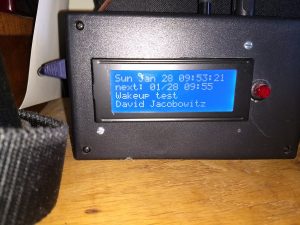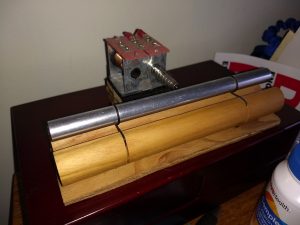Plenty of people have written about the fact that in a world of companies selling IOT hardware, there is little or no incentive for them to maintain the software running on that hardware. Those people are right. But not only is there little incentive, keeping an IOT device current is actually fiendishly difficult — as I was reminded this past weekend.
Background
I have an IOT alarm clock I built myself, back in 2011. It was based around a Raspberry Pi Model 1B, running Raspbian Wheezy. The software I wrote to imeplement the clock is simple, consisting of three major components:
- An interface to the Google Calendar API, so it knows when I want to get up
- An interface to an LCD Display so I can see the time and see when it plans to wake me next.
- An interface to GPIO to drive a solenoid, which rings a physical chime. I wasn’t going for a wimpy electronic beeping; I wanted some Zen-level physical dinging.
Now, when I created this clock about seven years ago, my go-to language for this sort of thing was Perl. You can quibble with that choice, but Perl was my Swiss army knife at the time, and it also solved certain problems that other languages didn’t. For one, Perl has a fantastic no-no

nsense library for wrapping C code: Inline. You can basically “inline” C function right in your Perl, and it “just works.” This was really important for talking to the chip GPIO for the dinger and for the LCD, which were supported only in C — at the time.
One drawback of using Perl is that Google has never supported it for accessing their APIs. That is, Perl can generate an HTTP transaction just as well as the next language, but Google also provides nice wrapper code for a list of languages which they’ve made it pretty clear will never, ever include Perl. But someone else had written a similar wrapper for Perl, so I grabbed that and got things up and running. Over the years, that has turned out to be a pain as Google has revamped their Calendar API twice in that time, and my clock just broke each time. Fixing it as a pain, but I did it just to keep the project running.
Let’s get current!
So, on Friday, after thinking about all the exploits floating around and the fact that I was running a full-fledged OS on a clock on my home network, I decided I should really update all the software on the clock. Raspbian had moved from Debian 7 (Wheezy) to Debian 8 (Jessie) to Debian 9 (Stretch) in the intervening years, so the first step was to update the OS. Twice.
This went poorly. The update process was excruciatingly slow on this single-core processor, taking hours, and occasionally stopping entirely to ask me a question (“you want to overwrite this file?”). I managed to get the first update done, but the second update died entirely when the SD card holding everything filled up after the installer decided it needed to create a huge swapfile.
So I got a new SD card and installed Stretch on that cleanly. It was also pretty quick, and if you do a network install, you won’t need to do any package updates immediately after. (Microsoft could learn a lesson from that.) After the OS came up, I copied over my software and tried to get it running. No dice.

You won’t be surprised to hear that some things had changed:
- The Perl libraries for Google had changed quite a bit over the years, so installing the new ones generated a bunch of errors. Overall, the main pain in this was that some of these libraries can be found in the Raspbian package manager, and some need to be installed from cpan. I prefer OS repository packages when available because they update along with the OS. Everything I install from cpan is just a snapshot that may may need to be installed after the next OS update, and worse, experience shows that the installation process can sometimes go from simple to epic if some underlying untracked dependency changes. But when you install from cpan, it installs dependency from cpan, even if the dependencies can be found in the OS repos. This basically sucks.
Anyway, the changes in the Perl libraries were mostly for the better, to make the Perl API better map to the way Google worked, but still, it required digging into my old Perl code and looking at the Google docs.
- The LCD interface is in two parts. A C-based daemon from a package called lcdproc, and my client code in Perl that talks to the daemon. For the new OS I needed to rebuild that daemon from source. Luckily, lcdproc had not advanced in 7 years, so I could just rebuild the old code. This was particularly lucky because I had made a big patch to the hardware driver to talk to my particular i2c expander that drover the LCD controller. I’m glad I did not have to figure out how to apply that patch to some completely new, changed version.
- Raspbian Stretch switched from System V init to systemd, so my startup stuff, which was init based needed to be changed to systemd unit files. This was not too painful, and I actually like systemd for daemons, but it took a little while to create the files, set permissions, fix my mistakes, yadda.
Overall, this whole project was not really that complicated in retrospect, but taking more or less an entire weekend day, it sure felt like a never-ending series of missteps and annoyances.
Getting Really Current
I should probably rewrite the clock in Python.
- Python now has a mature library for talking to Raspberry Pi GPIO. It’s clean and simple.
- Python has always had better Google integration, courtesy of Google. It would a pleasure to switch to this.
- I had already written Python bindings to talk to the LCD daemon. I don’t remember doing that, but apparently this is not the first time I’ve considered doing a Python rewrite.
But there are two roadblocks. First, technically, being a clock, this code is time-sensitive, and so the Perl version has multiple threads. There is basically a thread that increments every second and various worker threads. The modern Pythonic way to accomplish the same thing (without threads — which Python has never done well and never will) is to use asyncio. Not to get into the details too deep, but I have some issues with asyncio. It’s complicated and it requires an all-or-nothing approach. Your whole program, even the non async parts need to be asyncio-ified, because they will otherwise block the parts that are.
Second, I just don’t want to. Writing code that does the same thing as other code is no fun.
Alas
Anyway, today my alarm clock works exactly as it did in 2011, but it is running on a current version of Perl with current libraries on a current OS. It only took me the better part of my weekend. 🙁
Whose going to do this for the IOT power outlet or window shade controller you bought at Fry’s?